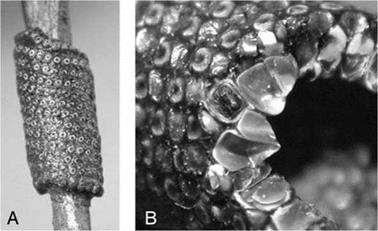8.16.3.1 Permanent Adhesion in Insects and Spiders
The coxal vesicles in representatives of the family Machilidae (Archaeognatha) serve to cement the old cuticle during skinning (ecdysis). The exact composition of the cement remains unknown, but it cannot be removed from the surface by the use of water, saline or acetone.
Parasitic insects such as lice or dipterans from the family Oestridae (Hypoderma — tinae) possess specialized glands to glue their eggs to the host hairs. Hypodermatin eggs also have specialized attachment organs which consist of a flexible petiole and a prominent clasper. The clasper, which is responsible for affixing the egg on a host hair, consists of an attachment groove filled with adhesive substance and a pair of adhesive-coated lateral flanges [114, 115]. The host hair is locked within the groove, and the adhesive solidifies around it. Many other species of insects also use glue-like substances to attach their eggs to each other or/and to the substrate (Figure 8.87).
Adhesive substances are also used for prey capture by orb-web spiders. These spiders use the secretion of the aggregate glands (the essential components of which are glycoproteins) to cover a so-called ‘sticky spiral’ [86,116]. Various types of spider
|
Figure 8.87 Egg aggregation in the moth Malacosoma neustria (family Lasiocampidae). (A) Eggs attached to the tree branch; (B) eggs glued to each other. |
silk have different tenacity under dry, moist and dusty conditions [117]. The silk of the spiders Filistata insidiatrix and Tegenaria atrica demonstrated especially high tenacity (2.3-2.7 mN cm-2). Dusty conditions usually reduce tenacity.
8.16.4
 19 января, 2016
19 января, 2016  Pokraskin
Pokraskin 
 Опубликовано в рубрике
Опубликовано в рубрике 